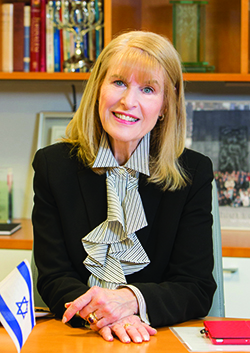Hadassah
President's Column
The Plural of Esther
 In Jewish tradition, questions are often held to be as important—and sometimes more important—than answers. So allow me to reflect on a perennial question of mine: Is it a coincidence that Hadassah was founded in the season of Purim?
In Jewish tradition, questions are often held to be as important—and sometimes more important—than answers. So allow me to reflect on a perennial question of mine: Is it a coincidence that Hadassah was founded in the season of Purim?
Hadassah’s mission and organizational identity are deeply rooted in the Purim story. The Megilla involves a daughter of her people who has a Hebrew name (Hadassah), indicating spiritual and familial loyalty, and a worldly name (Esther) that allows her to live outside her community without fear of prejudice. At the crucial hour, using intelligence and courage, she reveals her true identity and saves her people.
Our Hadassah emerged in a modernizing world that still left women on the margins. Shut out of leadership roles in the new Zionist movement (not to mention denied the vote under American law), our founders took their fate into their own hands. Their goals were to do good work and strengthen themselves.
They had a two-pronged agenda—to continue studying, mostly Jewish texts, and thereby improve their minds; and to engage in a plan of practical Zionism, creating institutions in Palestine that would help lay the foundation of a Jewish state.
Hadassah’s members soon found that their efforts were saving others. By building the medical and educational infrastructure of a new state, they rescued countless lives and minds. Hospitals and schools of medicine, nursing, dentistry and public health, all bearing Hadassah’s name, transformed the landscape of Israel. We also shared our expertise with the rest of the world.
Through it all, across the generations, Hadassah’s women kept studying together, as we do today. That first generation of members, most of whom had no experience of college or work outside the home, started organizing, fundraising and giving speeches. Their granddaughters are a highly educated, professional army of leaders.
Like Queen Esther, we have operated in the wider world—from the friendly corridors of Washington to the often-hostile halls of the United Nations, from the suspicious streets of the former Soviet Union to the forums without borders on global health care—under a Jewish banner. We are known and esteemed for who we are and what we do.
And just as we are respected in America and around the world, we are beloved in Israel, a fixture of the landscape and culture. Millions of Israelis have been personally touched by our work. We have a reputation for excellence and our name carries influence.
The biblical Queen Esther, depicted as beautiful in scripture and in contemporary art, lived about 2,500 years ago. Hadassah is about to turn 104—and we’re looking pretty good, too.
But unlike a heroine who is fixed in time, Hadassah is always a work in progress. In fact, the last thing we want is for our organization to become fixed in time by ceasing to be what it is. We rely on the continued inspiration of our tradition and from one another to make a difference for the Jewish people, the State of Israel and humanity.
If saving lives is part of our legacy, projecting that legacy into the future requires staying strong. If you thought increasing membership was the job of your chapter’s membership chair, think again. It’s up to each of us to share the pride, fellowship and satisfaction that are the best tools to attract new women and ideas. It’s up to us to demonstrate to our own community and to others how much value Jewish and Zionist activism adds to the world.
The Jewish people are more democratic today. Instead of a single queen, there’s a bit of Esther in all of us—including the women who have not yet found us. This would be true even if Hadassah had been founded in May or November.
Perhaps the answer to my original question lies in a midrash never written. If Hadassah had been founded in a different season, some scholar or novelist eventually would have come along to connect our founding with Esther just the same.
Chag Purim Sameach. Let’s continue to make noise and defeat the modern-day Hamans of the world.










 Facebook
Facebook Instagram
Instagram Twitter
Twitter
Leave a Reply